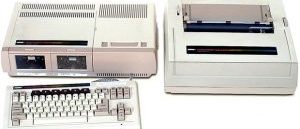Consumer-level computers have been getting smaller and smaller. Gone are the days when computers were large, bulky pieces of machinery that were only available to the wealthy. Since the inception of the computer one, overall goal has been to make computers faster, more powerful and much smaller. The industry’s goal is to be closely aligned with Moore’s Law. Moore’s law is the observation that the number of transistors in a dense integrated circuit doubles approximately every two years. This meant that computer chips would be able to be made smaller and more powerful! The reality of Moore’s law is one of the major drivers of smaller and smaller computer sizes. In addition to Moore’s Law, people’s desire to do more mobile computing, and increasing manufacturing situations where smaller and smaller computers were need for devices and gadgets that were also trending to smaller sizes.
In the early 60’s, mainframe computers were huge and could easily take up a whole room. Following the ‘mainframe’ era , was the era of the personal computer. The personal computer is what began to find itself in many consumer homes (remember early Texas Instrument computers and ADAM computers) .
There were several improvements made to personal computers, which made them smaller and more powerful. This led to the popularity of the laptop and it’s derivative, the netbook or mini laptops. Laptops and netbooks made carrying your computer a lot easier allowing you to productive on-the-go.
Though mobile devices had already been established in the market, more and more, mobile phones were becoming more like hand-held computers. There was the short-lived era of the PDA (personal digital assistant) devices but before long smart-phones became the standard. A smartphone is a composite device that combines the functionalities of a PDA and a cell phone. Many smartphones have impressive computing power. Computers have continued to get smaller, but for the average consumer they are not really practical to use and are mainly used by developers, manufacturers and hobbyist.
 |
 |
So with all computers getting smaller, why will we always need desktops?
Advantages of Desktop Computers:
- Desktop computers are more conducive to productivity. People tend to be more productive with their computer time when sitting at a desktop computer. The simple fact that they are sitting at a desk helps people be more alert, task oriented and focused. Typing on a desktop keyboard, using a mouse and having more screen space all lead to greater productivity. Desktop computers can often be more powerful, allowing for greater computing power and greater productivity. Laptops tend to get used in places that we are too comfortable or too uncomfortable. When we are too comfortable, we are less likely to stay focused on a specific task, our minds wonder and often find ourselves staring at a screen fighting sleep. When we are too uncomfortable, we are more likely to leave the task unfinished, rushing to get done so that you can return to comfort. Ever try working on a laptop while sitting on the couch and laptop sits on a coffee table? Your back soon gets tired from the constant bending over. Laying across the bed and using the laptop can often lead to neck pain and puts your laptop in danger of over-heating due to its exhaust fans being blown directly into your mattress.
- Ease of use. Desktop computers are like furniture, in that they are set up and ready to use. You don’t have to search the house for the power cord or your mouse because it remains in its place. Speaking of mouses (or mice); it is much easier to use a full-sized mouse or trackball than it is to use a laptop track-pad! Smartphones are great for a lot of things, but fall short on many tasks because of their small screen size and lack of a mouse or similar input device. Ever try creating an Excel spread sheet on a smartphone? It can be done, but not with a great amount of ease.
- Desktops are Expandable. Desktops are made to be expandable. They have extra slots and interfaces/ports that can be used for peripheral cards (graphics cards, SCSI cards, etc) that add or increase the computer’s functionality. Most desktops are manufactured with expansion in mind. Motherboards usually have extra slots to install and increase RAM, add another hard drive and/or a disc reader. You can plug a ton of peripherals into desktops. Most laptops have a limited number of USB ports and if you need some other, legacy or lesser-used ports, you can almost forget about having them on a laptop. If you need DVI, VGA, SCSI or some other legacy port, you will be hard-pressed to find them in most laptops. With desktops, these ports can be added by simply installing an expansion board/card. Desktops offer you options to use two monitors a one; giving you greater screen real estate.
- Desktops are more affordable and a better value. Though all computers have decreased in price as manufacturing and chip costs decrease, desktops remain the best value. You will almost always get more ‘bang’ for your buck when you purchase a desktop computer as compared to a laptop, netbook , tablet or smartphone. Desktops generally have more RAM, larger hard drives, larger screens, and more room to upgrade than other types of computers at the same price point.
- Desktops last longer. Desktops are the best value because they tend to last much, much longer than other types of computers. They are at a greatly reduced risk of damage simply because they are not transported around very often, unlike mobile computer devices. Because they are stationary, things are not plugged and unplugged excessively and they are less susceptible to theft or loss. Desktops are the easiest and most affordable type of computer to have repaired. Many components in laptops, netbooks and smartphone computers are integrated into the motherboard to preserve space. The problem with that is; if your USB ports are hard-wired to your motherboard and they stop working, replacement isn’t really cost-effect because the entire motherboard would need to be replaced. Whereas desktops have expansion slots that a new USB card can be installed in even if the old, broken ports are hard-wired. Desktops allow easier, less expensive repairs because they are modular. You can replace your power supply, graphics card, processor, or most any component, independently of any other component in the computer. Desktop parts are generally cheaper and are not as brand specific. Desktops usually come in cases that allow greater air-flow, keeping heat-sensitive components cooler and less likely to fail. Laptops are infamous for heat related damage because everything inside is so close and packed in to fit the available space, that heat builds up fast.
The type of computer you use should be dictated by what you are using it for. If you are mobile most of the time and need to complete tasks on the go, laptops are great. If you really, only need to view documents and handle scheduling functions, your smartphone will work like a charm. Mobile computing is a wonderful thing and is here to stay, but the good ole’ desktop is still the king when it comes to personal computers!
FAQ
If I only have one computer what type should it be?
It really depends on your budget and primary use for the computer. In general, I would say get a laptop first. This will give you the most flexibility with when, where and what you want to do with the computer. If you get a second computer, then make that one a desktop. Most people have phones already so I didn’t include them here
Written by Keith Barney









